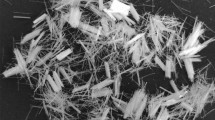Abstract
A process was development for researching the finger dynamics using digital image analysis and the soil water content concept model. Nonuniform wetting front profile expanded vertically under the equalized potential head horizontally. Experimental data and the present concept model matched adequately. For extending the application of concept model, hysteresis models (Hogarth in 1988 and Huang in 2005) are compared. The initial temporal and spatial fingered velocity was faster with time under the same rainfall intensity, as well as fingered width. Besides, the mean fingered velocity also increase with rainfall intensity. The present concept model expounded the evolution of lingered flow and the hydraulic properties of linger dynamics successfully.
Similar content being viewed by others
References
R. S. Baker and D. D. Hillel, “Laboratory Tests of a Theory of Fingering during Infiltration into Layered Soils,” Soil Sci. Soc. Am. J. 54, 20–30 (1990).
T. W. J. Bauters, J. G. Christophe, T. S. Darnault, T. S. Steenhuis, and J.-Y. Parlange, “Lateral Expansion of Preferential Flow Paths in Sands,” Wat. Resour. Res. 35, 427–434 (1999)
R. H. Brooks and A. J. Corey. 1964. “Hydraulic Properties of Porous Media,” Hydrol. Pap. 3, Colo. State Univ., Fort Collins, Colo, USA (1964).
H. Cho, and G. H. de Rooij, “Pressure Head Distribution during Unstable Flow in Relation to the Formation and Dissipation of Fingers,” Hydrol. Earth Syst. Sci. 6(4), 763–771 (2002).
G. H. de Rooij, “Modeling Fingered Flow of Water in Soils owing to Wetting Front Instability: A Review.,” J. Hydrol. 231–232, 277–294 (2000).
M. R. Deinert, J.-Y. Parlange, T. S. Steenhuis, et al., “Measurement of Fluid Contents and Wetting Front Profiles by Real-Time Neutron Radiography,” J. Hydrol. 290, 192–201 (2004).
D. A. DiCarlo, “Experimental Measurements of Saturation Overshoot on Infiltration,” Wat. Res. Res. 40, 204–215 (2004)
D. A. DiCarlo and M. J. Blunt, “Determination of Finger Shape Using the Dynamic Capillary Pressure,” Wat. Res. Res. 36(9), 278l–2785 (2000).
R. J. Glass, J.-Y. Parlange, and T. S. Steenhuis, “Wetting Front Instability I. Theoretical Discussion and Dimensional Analysis,” Water Resour. Res. 25(1), 187–1194 (1989).
R. J. Glass, T. S. Steenhuis, and J.-Y. Parlange, “Wetting Front Instability 2. Experimental Determination of Relationships between System Parameters and Two-Dimensional Unstable Flow Field behavior in Initial Dry Porous Media,” Wat. Resour. Res. 25, 1195–1207 (1989).
R. J. Glass, T. S. Steenhuis, and J.-Y. Parlange, “Mechanism for Finger Persistence in Homogeneous, Unsaturated, Porous Media: Theory and Verification,” Soil Sci. 148, 60–70 (1989c).
D. E. Hill and J.-Y. Parlange, “Wetting Front Instability in Layered Soils,” Soil Sci. Soc. Am. Proc. 36, 697–702 (1972).
W. L. Hogarth, J. Hopmans, J.-Y. Parlange, and R. Haverkamp, “Application of a Simple Soil-Water Hysteresis Model,” J. Hydrol. 98, 21–29 (1988).
H. C. Huang, Y.-C. Tan, C.-W. Liu, and C.-H. Chen, “A Novel Hysteresis Model in Unsaturated Soil,” Hydrol. Proc. 19(8), 1653–1665 (2005).
Y. Liu, B. R. Bierck, J. S. Selker, et. al., “High Intensity X-ray and Tensiometer Measurements in Rapidly Changing Preferential Flow Fields,” Soil Sci. Soc. Am. J. 44, 892–898 (1993).
Y. Liu, J.-Y. Parlange, and T. S. Steenhuis, “A Soil Water Hysteresis Model for Fingered Flow Data,” Wat. Resour. Res. 31, 2263–2266 (1995).
Y. Mualem, “A Conceptual Model of Hysteresis,” Wat. Resour. Res. 10,(3), 514–520 (1974).
J.-Y. Parlange and D. E. Hill, “Theoretical Analysis of Wetting Front Instability in Soil,” Soil Sci. 122, 236–239 (1976).
C. J. Ritsema, L. W. Dekker, J. L. Nieber, and T. S. Steenhuis, “Modeling and Field Evidence of Finger Formation and Finger Recurrence in a Water Repellent Sandy Soil,” Wat. Resour. Res. 34, 555–567 (1998).
J. S. Selker, J.-Y. Parlange, and T.S. Steenhuis, “Fingered Flow in Two Dimensions. Part 2: Predicting Finger Moisture Profile and Measurement of Conductivity,” Wat. Resour. Res. 28, 2523–2528 (1992).
B. C. Si, and R. G. Kachanoski, “Unified Solution for Infiltration and Drainage with Hysteresis: Theory and Field Test,” Soil Sci. Soc. Am. J. 64, 30–36 (2000).
M. T. van Genuchten, “A Closed-Form Equation for Predicting the Hydraulic Conductivity of Unsaturated Soils,” Soil. Sci. Soc. Am. J. 44, 892–898 (1980).
Author information
Authors and Affiliations
Corresponding author
Rights and permissions
About this article
Cite this article
Ma, KC., Tan, YC. & Chen, CH. Effect of hysteresis and infiltration rate on finger dynamics. Eurasian Soil Sc. 42, 1504–1514 (2009). https://doi.org/10.1134/S1064229309130110
Published:
Issue Date:
DOI: https://doi.org/10.1134/S1064229309130110




